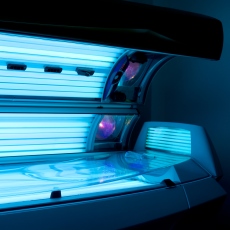

06/29/2017 04:22 PM EDT
Source: Mayo Foundation for Medical Education and Research
Related MedlinePlus Pages: Tanning
06/29/2017 04:22 PM EDT
Source: American Cancer Society
Related MedlinePlus Pages: Tanning National Institutes of HealthCan a tan be healthy?
Some people think that tanning gives them a healthy glow. But tanning, either outdoors or indoors with a tanning bed, is not healthy at all. It exposes you to harmful rays and puts you at risk for health problems such as melanoma and other skin cancers.
What are UV rays, and how do they affect the skin?
Sunlight travels to earth as a mixture of both visible and invisible rays. Some of the rays are harmless to people. But one kind, ultraviolet (UV) rays, can cause problems. They are a form of radiation. UV rays do help your body make vitamin D, but too much exposure damages your skin. Most people can get the vitamin D that they need with only about 5 to 15 minutes of sun exposure two to three times a week.
There are three types of UV rays. Two of them, UVA and UVB, can reach the earth's surface and affect your skin. Using a tanning bed also exposes you to UVA and UVB.
UVB rays can cause sunburn. UVA rays can travel more deeply into the skin than UVB rays. When your skin is exposed to UVA, it tries to protect itself from further damage. It does this by making more melanin, which is the skin pigment that makes your skin darker. That's what gives you a tan. This means that your tan is a sign of skin damage.
What are the health risks of tanning?
Since tanning means overexposure to UV rays, it can damage your skin and cause health problems such as
What should I do to protect my skin from UV rays?
It is also important to check your skin once a month. If you do see any new or changing spots or moles, go see your health care provider.
Isn't indoor tanning safer than tanning in the sun?
Indoor tanning is not better than tanning in the sun; it also exposes you to UV rays and damages your skin. Tanning beds use UVA light, so they expose you to a higher concentration of UVA rays than you would get by tanning in the sun. Tanning lights also expose you to some UVB rays.
Some people think that getting a "base tan" in a tanning salon can protect you when you go in the sun. But a "base tan" causes damage to your skin and will not prevent you from getting sunburn when you go outside.
Indoor tanning is particularly dangerous for younger people. You have a higher risk of melanoma if you started doing indoor tanning while you were a teen or young adult.
Some research shows that frequent tanning may even be addictive. This can be dangerous because the more often you tan, the more damage you do to your skin.
Are there safer ways to look tan?
There are other ways to look tan, but they are not all safe:
|






















.png)











No hay comentarios:
Publicar un comentario